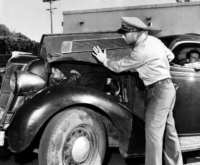About a fifth or more of the EEOC’s charges each year involve sexual harassmentBy Paul Igasaki, IMDiversity.com Featured EEO Columnist
A few years back, when I was acting as Chair of the Equal Employment Opportunity Commission, I hosted a group of senators from Belgium. They were interested in discrimination laws in the U.S., but this was shortly after the record-breaking settlement of the Mitsubishi Motors sexual harassment case, so discussion focused on that form of discrimination. One of the men in the delegation commented that he felt that it was a reflection of societal change in attitudes towards sexuality and he wondered why it should be a discrimination issue. Together, the female senators said in unison, “Consent.” They were right. That sexual harassment is a discrimination problem has to do with this basic principle, a person having to endure something they shouldn’t have to against their will. But while this is, I think, a simple issue, its application is much more complicated. Sexual harassment wasn’t considered discriminatory until the 1980’s and then, the number of claims were few. That all changed when former EEOC Chair Clarence Thomas, during his Supreme Court confirmation hearings, was accused of sexual harassment. The high visibility case became a national teach-in on sexual harassment and regardless what happened in that case, it has not been the same since. About a fifth or more of the EEOC’s charges each year involve sexual harassment. While clearly long a reality in the workplace as well as other venues, this has become a big issue both here in the U.S. and around the world only recently. It is an area where America’s workplace changed during my watch at EEOC. When I announced the Mitsubishi lawsuit in 1992, a case involving hundreds of incidents that may have constituted sexual harassment, dealing with a company’s overall atmosphere had been done, but the case illustrated what would happen if it were not handled at that level. I went to Japan twice at the request of groups in Japan in the case. While the status of women in Japan lags behind women in the U.S. in many ways, both nations have begun to address this issue. Our nation’s emphasis on litigation, while often not constructive, has resulted in much quicker changes in workplace policies, mostly for the better. The Supreme Court, in a series of cases designed to clarify the law in this area, has provided some guidance that emphasizes that a company’s liability may depend upon what the company did when and if they found out about the claim, as well as whether the company had a fair system for finding and responding to charges of harassment. If the company didn’t know about it, there isn’t a lot they could do, unless the facts show that they should have been aware of it. (For a more detailed discussion of management’s responsibility, see the previous column, “Racial & Ethnic Harassment in the Workplace“, at the end.) Where the harassment comes from management, however, the company’s knowledge is inferred. Claimants are expected to use a system that is considered reasonably safe and objective if they are to have a right to make a claim.
If a complainant claims sexual harassment and the alleged harasser denies it with no additional witnesses to the incident, does that mean the claimant loses?
Not necessarily. The biggest area of conflict in these cases involves the “he said, she said” reality of sexual harassment. The nature of sexual harassment is such that many incidents take place without witnesses except for the alleged harasser and alleged victim. One person’s word against another’s will turn on credibility if there are no other witnesses. A claimant may say that their boss grabbed them or threatened to promote someone over them unless they complied sexually. The boss may deny that it happened, or that innocent actions or words were misinterpreted. Often, more experienced and higher ranking employees are more likely to be believed, but if a company resolves claims this way it will get into serious trouble fairly quickly. Employers throwing up their hands in the face of two different versions will not do here. The most reliable way to seek corroboration involves reviewing a person’s past record at the company or elsewhere. Accepting that harassment is often about power, it appears to be true that serious harassers have done it before. That doesn’t mean that there have been previous claims. Past victims may have been intimidated, or the harassment may have been more minor previously. Sometimes other victims will come forward when they hear of cases similar to their own. Can harassment be committed only by a boss, or can coworkers, customers or others illegally harass a worker?The cases called “quid pro quo” involve situations where a job or a benefit is threatened or offered based on a subordinate’s going along with sexual demands. In these cases, the harasser is in a superior position to the victim. Management responsibility can be established if the harassment took place. Juries are most distressed if management does not act once they find out about it. An increasing proportion of the cases involve situations where a hostile environment is created for an employee. The harassment here can come from a manager or from other sources. Here, unwelcome advances are made serious enough to interfere with a worker’s ability to do her or his work. This can range from inappropriate touching, repetitive requests for a date to sexually offensive messages or images (verbal, written or electronic). Determining whether a situation involves harassment takes more information considering the severity or frequency of the act. One request for a date will usually not be enough, but doing so repeatedly following a refusal may. One off-color joke inadvertently heard in a employee lounge would probably not be enough, but being constantly confronted with such jokes over email for example probably would be. There are no clear rules here and a consideration of all the circumstances would be necessary. Harassment could come from customers or from other workers. Management’s knowledge of it is more critical here. Either they must know or should have known based upon the circumstances. Can the existence of a consensual relationship ever become sexual harassment?
Yes and it occurs not infrequently. In such cases, the relationship is generally ended by one party and not accepted by the other. For this to become harassment, the withdrawing partner must withdraw their consent for the relationship to continue. The other rules of harassment then apply. Can a woman harass a man?Yes. It doesn’t happen as often because there are fewer women in management positions or in certain workplaces. One case involved a regional supervisor who allegedly harassed a fast food restaurant’s manager, taking professional action against him when he refused advances. Environmental harassment can also occur, though since this often involves harassment of one whose gender is in a minority in the workplace, this is also relatively infrequent. While this never evolved into a case, someone once told me about a female worker in a male environment who routinely told sexually offensive jokes, making some uneasy. Can the harasser be of the same sex as the victim?Yes. While at the federal level, there is not a law yet that makes discrimination based on sexual orientation unlawful, this does not preclude sexual harassment claims involving same sex. I do expect, given public opinion, that sexual orientation will become protected against discrimination. Also, a number of states and localities have such protections already. Sexual harassment, however, that involves harassment of an employee who “appears to be” gay or lesbian could still be unlawful. The content of the harassment is generally sexual in nature as opposed to because a person is gay or lesbian. Many of the cases I have heard about, though not all, have involved complainants who are not gay.
As with other forms of harassment, though especially with sexual harassment perhaps due to the intensity of emotions that are often involved, retaliation is a serious problem. Companies need to make sure, regardless of the validity of the complaint, that no retaliation is taken against the complainant or witnesses in the case. This is as important while the case is being investigated as after it is concluded. I have seen sexual harassment become illegal, and companies and workers move to reduce its occurrence. Just as with racial harassment, I don’t expect it to disappear, but I am pleased to have participated in this sea change in the American workplace. Ultimately, it will make our workplace fairer and more effective.
Do You Have a Question about EEO?
Previous EEOCorner Column
|
||
|

 Paul Igasaki is a consultant in diversity, equal opportunity, government and community affairs. Recently, he edited A Call to Action, a historic policy platform for a coalition of national Asian Pacific American organizations. Appointed by President Bill Clinton, he served as Vice Chair or acting Chair of the U.S. Equal Employment Opportunity Commission from 1994 to 2002, gaining recognition for restructuring the agency to eliminate a crippling case backlog and for building credibility in protecting the rights of immigrant Americans and victims of sexual harassment. He previously served as Executive Director of the Asian Law Caucus in San Francisco and as Washington, D.C. Representative of the Japanese American Citizens League. He also worked for the City of Chicago, his hometown, as a liaison to Asian American communities and as a Mayoral advisor on human relations and affirmative action. His career also included efforts to provide civil legal services to the poor, both at the national level for the American Bar Association supporting collaborations between legal aid and private attorneys and at the local level as a legal services attorney in Sacramento, California. He is an attorney in California and Illinois, and was a graduate of Northwestern University and the University of California, Davis.
Paul Igasaki is a consultant in diversity, equal opportunity, government and community affairs. Recently, he edited A Call to Action, a historic policy platform for a coalition of national Asian Pacific American organizations. Appointed by President Bill Clinton, he served as Vice Chair or acting Chair of the U.S. Equal Employment Opportunity Commission from 1994 to 2002, gaining recognition for restructuring the agency to eliminate a crippling case backlog and for building credibility in protecting the rights of immigrant Americans and victims of sexual harassment. He previously served as Executive Director of the Asian Law Caucus in San Francisco and as Washington, D.C. Representative of the Japanese American Citizens League. He also worked for the City of Chicago, his hometown, as a liaison to Asian American communities and as a Mayoral advisor on human relations and affirmative action. His career also included efforts to provide civil legal services to the poor, both at the national level for the American Bar Association supporting collaborations between legal aid and private attorneys and at the local level as a legal services attorney in Sacramento, California. He is an attorney in California and Illinois, and was a graduate of Northwestern University and the University of California, Davis.






